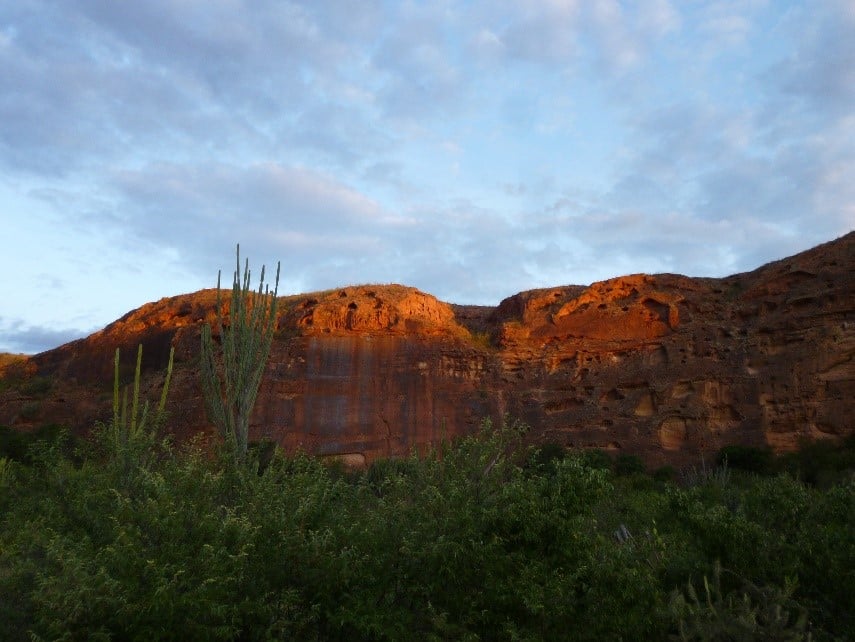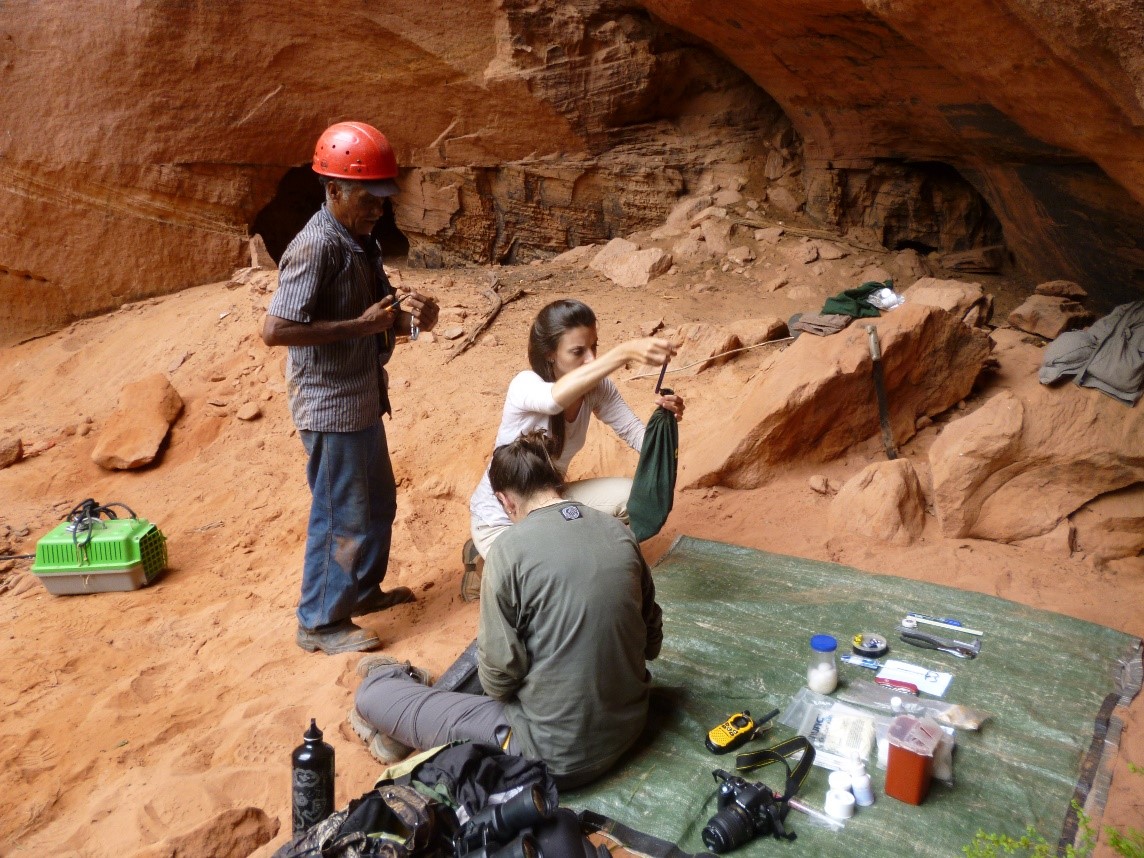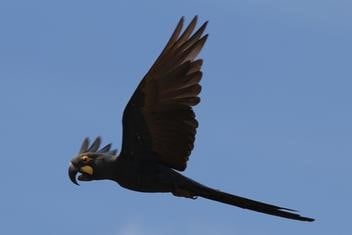Your cart is currently empty!

HARI Official Brand Site

A magnificent blue color, the Lear’s Macaw lives in only a very small area of the Northeastern State of Bahia, Brazil.
A magnificent blue color, the Lear’s Macaw lives in only a very small area of the Northeastern State of Bahia, Brazil. This is a sparsely populated area that resembles Texas with its dry cactus-filled scrub forest and cattle ranches. This habitat has remote sandstone cliffs with cavities that are the sole breeding ground for the Lear’s Macaws. In the last decade the macaws have faced increasing competition for their nesting cavities. This competition is not from other birds, or even mammals, but from an insect. The invasive Africanized Honey Bees (AHB) have steadily increased in number and are excluding macaws from cliff cavities, limiting their breeding success. These bees are also promoting habitat destruction, poaching, and they pose a risk to the scientists studying the macaws.

In the year 2000, the Lear’s Macaws only numbered around 800. Habitat degradation, poaching and shooting of macaws because they raided corn fields were reducing their numbers. A team of scientists, led by Dr. Erica Pacífico and Thiago Filadelfo, began studying the Lear’s Macaws in 2008. They conducted roost counts of birds and rappelled down cliff walls, crawling into nest cavities to access macaw chicks. They took body measurements, weight, and blood samples and banded the chicks. During this time, they saw an increase in the number of bee colonies nesting in the sandstone cliffs, including cavities previously used by the macaws for breeding. In 2014 they published findings that only an estimated 20% of the population was breeding. This is very low for an endangered species and cause for concern. They hypothesize that this low percentage is due to food availability and nest site limitation.
The increase in the number of bee colonies in cliff walls became so numerous that it began limiting researchers’ access to macaw nests. Due to the AHBs’ highly defensive behavior, which earned them the nickname “killer bees”, even bee colonies near macaw nests posed a danger to rappelling researchers. This required that when rappelling down cliff walls, they wear a full beekeeping suit and carry a smoker (this covers up the bees’ alarm pheromones so that cannot communicate to other bees that they are under attack) to protect themselves from being stung by the bees. Often though, researchers were just not able to access many of the macaw nests, hampering date collection.

The AHBs were brought to Sao Paulo, Brazil in 1954 for a genetic experiment to breed a bee more suitable to tropical climates. Unfortunately, they escaped into the environment and quickly spread throughout South and Central America and into the northwestern part of the U.S., arriving in the habitat of the Lear’s Macaws in 1970. They are considered the most successfully invasive insect ever.
At a parrot conference in 2012, Dr. Pacífico met Dr. Caroline Efstathion, who at the time was studying ways to reduce nest site competition for nest cavities between honey bees and parrots. The two discussed the bee issue with the Lear’s Macaws and a collaboration began.

Avian Preservation and Education Conservancy (APEC), a 501c3 non-profit organization, was founded by Dr. Efstathion and Rob Horsburgh. Dr. Efstathion eventually developed a method called “Push-Pull” to reduce nest site competition with AHBs. This method “pushes” bees away from parrot nest cavities with an insecticide that is repellant to bees, but safe for the birds and “pulls” the bees toward an artificial swarm trap box (an alternate place for the bees to make a home) with an attractive pheromone (substance that smells like home to the bees).
The idea is that scouting bees looking for a new home will be more attracted to the swarm trap with the lure. The bees should move into the swarm trap that is designed to be more suitable to their preferences and not occupy the nest box with the repellent.
Over the past several years, APEC has been visiting the Lear’s Macaw nesting sites and implementing the “Push-Pull” method. Even though AHBs are considered an invasive species, people have learned to use them for producing honey, propolis and wax products, much like the European honey bees. Recognizing that the captured bees are a resource, APEC began using beekeeping as a conservation tool to educate local farmers about the Lear’s Macaws and to encourage beekeeping. A culture of honey hunting has developed in the Caatinga area, where locals climb the cliffs to steal honey from the bees. People construct stick ladders in the cliff walls to access the bee colonies. Often, these honey hunters also construct ladders that lead directly to macaw nests. In this way, the bees have contributed to promoting the poaching of macaw chicks, because they are near the bee colonies. From interviews conducted with local farmers, we learned that outsiders come into the area to collect honey however, they are not coming in honey season, but rather during macaw breeding season. This leads us to believe that people are using the bees as a justification to be in the area to poach macaws and other parrots in the Caatinga.

We also found that people chop down large hollow trees that have bee colonies to get to at the honey. Due to the extensive habitat degradation, there are few remaining trees large enough to house bee colonies and therefore this destruction of trees is contributing to further habitat destruction. Our goal is to reduce these bee associated threats by teaching managed beekeeping to some of the local farmers.
Beekeeping can provide an environmentally friendly way for a farmer to get additional income. Unlike other forms of agriculture that require the clearing of land and resources like water, beekeeping takes advantage of the nectar sources already available in the environment. APEC provides start up equipment like bee suits, smokers and wooden bee hives to the farmers and in exchange they monitor the swarm traps. The captured swarms are removed from the macaw nesting areas and brought back to the farmer’s home. These captured swarms provide hive products like honey, bees wax and propolis. Because of several ongoing efforts to protect the Lear’s Macaws, their population has increased to an estimated 1200, but the low breeding percentage is still a concern. APEC will continue to work in the Caatinga to reduce AHB issues that are hampering recovery efforts of the Lear’s Macaws.

APEC has done similar work in South Africa, Guatemala, the Caribbean and in Southeastern Brazil with other parrot species. For more information about APEC projects or to donate please visit our website at avainpec.org.
Article and photos provided on behalf of APEC.

Raising awareness for the conservation, preservation, and education of both captive and wild parrot species – because their future is our concern.